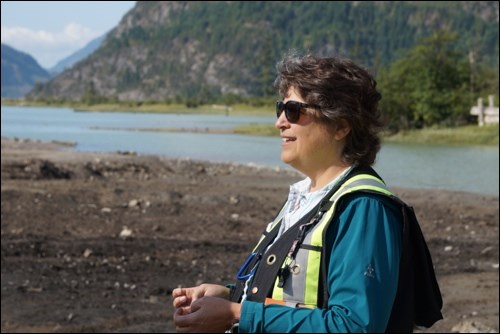Green rushes peek through the dirt under Edith Tobe’s feet and a blue heron comes in for a landing on the top of a tree overhead.
As the Squamish River Watershed Society executive director surveyed the former brownfield site in the Squamish Estuary last Thursday, there was still a large truck and excavator working, but the land that was once the site of the West-Barr Log sort looked much less like a moonscape than it did a few months ago.
The remediation on the east bank of the Squamish River, which sits within the Skwelwil’em Wildlife Management Area, is about 75 per cent complete, according to Tobe.
“It is cleaning up really nicely,” she said.
What in February was a flat, barren gravel site is now home to tidal channels, beached logs, greenery and a plethora of birds.
“What we are trying to do is make that all a beautiful sedge marsh meadow,” Tobe said, adding the restoration involves re-grading the site to the elevation of another nearby sedge marsh meadow.
The log-sort pond is being in-filled and graded to recreate a tidal mud flat.
Creating the correct elevation is key for vegetation, Tobe said. When elevation is above about one metre, grasses and silverweed and other species of shrub usually grow.
“Elevation dictates vegetation in the estuary and it is a beautiful thing,” Tobe said. “All we did was dig down and suddenly we have these cat tails coming up.”
Tidal channels are important because they allow the inflow and outflow of tidal waters.
“This provides habitat for fisheries for species like Coho, Chinook salmon, steelhead – basically all our salmonoids that can be found at one time or another in the estuary, as well as rainbow trout and sculpins and sticklebacks – so it is an important resource for fisheries.”
The marsh areas attract birds that use it as migratory routes.
“You can imagine when this was a log sort, if you are a bird you are not going to be stopping here, there is nothing for you, but once we convert it back… into beautiful functional habitat with trees and shrubs, with sedges, the birds are going to start using this as a resting place and a source for food,” Tobe said.
Work was halted on the restoration for a few weeks this spring when a large cache of wood waste and 30 square feet of leaked hydrocarbon from an old fuel tank left over from when the site was a log sort were discovered.
The removal of the wood waste has cost the society about $56,000 to date and the District of Squamish has approved the waste be stockpiled on Lot 69 by the airport, on land they are leasing from the province. The district didn’t charge tipping fees.
In addition to the odd tire, wood waste and some cable, workers uncovered the blue-listed Vancouver Island beggar tick species during restoration. The flowery plant that looks a bit like a miniature sunflower was growing too close to where the excavator was working so Department of Fisheries and Oceans estuary construction supervisor Sam Gidora, transplanted it to an out of way spot.
“It is really cool. This blue-listed provincially significant species is probably going to pop up all over the place next year,” Tobe said.
The restoration, which closed the area off to the public, began in March and won’t be totally finished until 2017, but estuary-lovers should be able to gain access to the area by September, Tobe said.
By then there will be a 300-metre walking and biking connector trail, including wooden footbridge, along the eastern edge of the site, she said.
There will be viewing spots along the trail and interpretive signs installed.
Later in the fall the community will be asked to come and help with some planting, Tobe said.
In the meantime, Tobe said the public should be aware the central estuary is an active construction site with large equipment operating so it is not safe for people to walk through.



